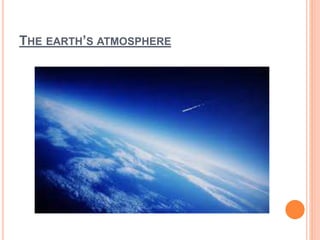
Layers-of-the-atmosphere.pptxhbjhcahghjjhsahsgsa
- 2. Atmosphere - the body of air and gases that protects the planet and enable life. Nitrogen 78%, Oxygen 21%, other gases 1% (Ar, Ne, He, Kr, Xe, CO2, CH4,O3,)
- 3. Blue light is scattered more than other wavelength by the gases in the atmosphere, giving Earth a blue halo when seen from space.
- 4. LAYERS OF THE ATMOSPHERE The atmosphere is divided into five layers according to major changes in its temperature. It is thickest near the surface and thins out with height until it eventually merges with space.
- 6. TROPOSPHERE The lowest layer of the atmosphere The layer where we live in and touches the earth’s surface. Almost all of the weather changes occur in this layer because it contains most of the water vapor.
- 7. Without water there would be no clouds, rain, snow or other weather changes. Air in the troposphere is constantly moving as a result aircraft flying through the troposphere may have a very bumpy ride – turbulence.
- 8. The height of the troposphere varies from the equator to the pole. About 17 km. around the equator about 12 km in the north and south areas of the equator About 6 – 8 km at the poles.
- 9. “Tropopause = the zone where the temperature remains constant. It divides the troposphere from the next layer.
- 10. Temperature drops about 6.50 C for every km above the earth’s surface. But the temp. seems to stop dropping at an altitude above 12 km.
- 11. Temperature in the stratosphere decreases as altitude increases.
- 13. STRATOSPHERE Is the layer of the air that extends to about 50 km from the Earth’s surface Lower stratosphere = air temperature remains constant and very cold at -60 C.
- 14. Many jet aircraft fly in this layer because it is very stable. Stratopause = zone of highest temperature. It seperate the stratosphere from the next layer.
- 15. Ozone = special form of oxygen it is formed when 3 atoms of oxygen combine to form as molecule. (oxygen that we breath has 2 atoms” total amount of ozone is very small but very important to life on earth.
- 16. Acts as a shield for the earth’s surface as it absorbs UV radiation from the sun. Ozone is responsible for the temperature increase in the upper stratosphere.
- 18. MESOSPHERE The temperature decreases as altitude increases. The air is thin in this layer, it absorbs only small amount of radiation from the sun. About 50 – 80 km above the earth’s surface
- 19. The temperature drops nearly -100 C “Upper mesosphere is the coldest region of the atmosphere”
- 20. It helps protect the Earth from meteoroids, large rock objects in space. When meteoroids enter the atmosphere, they burn up in mesosphere. However, some meteoroids are large enough to survive the passage and actually hit the Earth.
- 21. “meteorites” – the pieces of meteoroids that reach the surface of the Earth.
- 23. THERMOSPHERE Begins above the mesosphere at a height of about 80 – 110 km. a.k.a “heat sphere or warm layer” because temperature may reach 2000 C or more.
- 24. It is where the space shuttle and International Space Station (ISS) orbits and where the auroras are found. Aurora are caused when the solar wind strikes gases in the atmosphere above the Poles.
- 25. Ionosphere – is found within the thermosphere, ion-rich region. about 80 – 550 km above the earth’s surface.
- 26. nitrogen, oxygen and other gas particles absorb the uv and x – ray from the sun. they become electrically charge called “ions” They reflect radio waves, thereby making long distance radio communication possible.
- 28. EXOSPHERE The upper limit of our atmosphere This layer of the atmosphere merges into space.
- 29. Satellites are station in this area, 500 – 1000 km from Earth. It is the region where atoms and molecules escape into space.
- 30. FACT PHYSICS CONNECTION: The size of an inflated balloon increases as it flies up the atmosphere. This is because of the interaction between the high air pressure inside the balloon and the low air pressure outside the balloon. In the atmosphere, air pressure decreases as altitude increases.